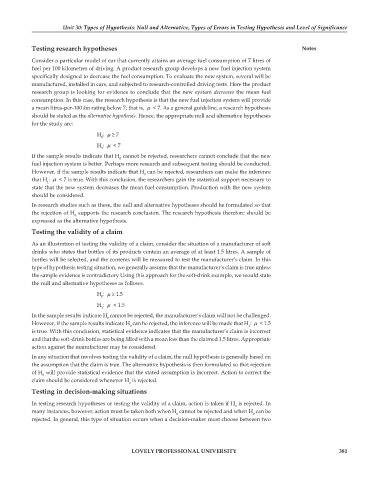Page 386 - DECO504_STATISTICAL_METHODS_IN_ECONOMICS_ENGLISH
P. 386
Unit 30: Types of Hypothesis: Null and Alternative, Types of Errors in Testing Hypothesis and Level of Significance
Testing research hypotheses Notes
Consider a particular model of ear that currently attains an average fuel consumption of 7 litres of
fuel per 100 kilometres of driving. A product research group develops a new fuel injection system
specifically designed to decrease the fuel consumption. To evaluate the new system, several will be
manufactured, installed in cars, and subjected to research-controlled driving tests. Here the product
research group is looking for evidence to conclude that the new system decreases the mean fuel
consumption. In this case, the research hypothesis is that the new fuel injection system will provide
a mean litres-per-100 km rating below 7; that is, μ < 7. As a general guideline, a research hypothesis
should be stated as the alternative hypothesis. Hence, the appropriate null and alternative hypotheses
for the study are:
H : μ ≥ 7
0
H : μ < 7
1
If the sample results indicate that H cannot be rejected, researchers cannot conclude that the new
0
fuel injection system is better. Perhaps more research and subsequent testing should be conducted.
However, if the sample results indicate that H can be rejected, researchers can make the inference
0
that H : μ < 7 is true. With this conclusion, the researchers gain the statistical support necessary to
1
state that the new system decreases the mean fuel consumption. Production with the new system
should be considered.
In research studies such as these, the null and alternative hypotheses should he formulated so that
the rejection of H supports the research conclusion. The research hypothesis therefore should be
0
expressed as the alternative hypothesis.
Testing the validity of a claim
As an illustration of testing the validity of a claim, consider the situation of a manufacturer of soft
drinks who states that bottles of its products contain an average of at least 1.5 litres. A sample of
bottles will be selected, and the contents will be measured to test the manufacturer’s claim. In this
type of hypothesis testing situation, we generally assume that the manufacturer’s claim is true unless
the sample evidence is contradictory Using this approach for the soft-drink example, we would state
the null and alternative hypotheses as follows.
H : μ ≥ 1.5
0
H : μ < 1.5
1
In the sample results indicate H cannot be rejected, the manufacturer’s claim will not be challenged.
0
However, if the sample results indicate H can he rejected, the inference will be made that H : μ < 1.5
0 1
is true. With this conclusion, statistical evidence indicates that the manufacturer’s claim is incorrect
and that the soft-drink bottles are being filled with a mean less than the claimed 1.5 litres. Appropriate
action against the manufacturer may be considered.
In any situation that involves testing the validity of a claim, the null hypothesis is generally based on
the assumption that the claim is true. The alternative hypothesis is then formulated so that rejection
of H will provide statistical evidence that the stated assumption is incorrect. Action to correct the
0
claim should be considered whenever H is rejected.
0
Testing in decision-making situations
In testing research hypotheses or testing the validity of a claim, action is taken if H is rejected. In
0
many instances, however, action must be taken both when H cannot be rejected and when H can be
0 0
rejected. In general, this type of situation occurs when a decision-maker must choose between two
LOVELY PROFESSIONAL UNIVERSITY 381

